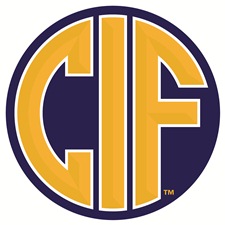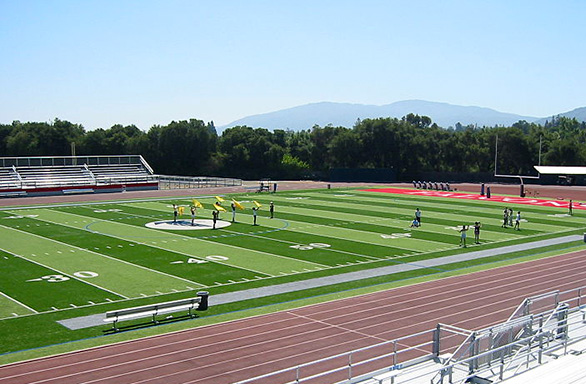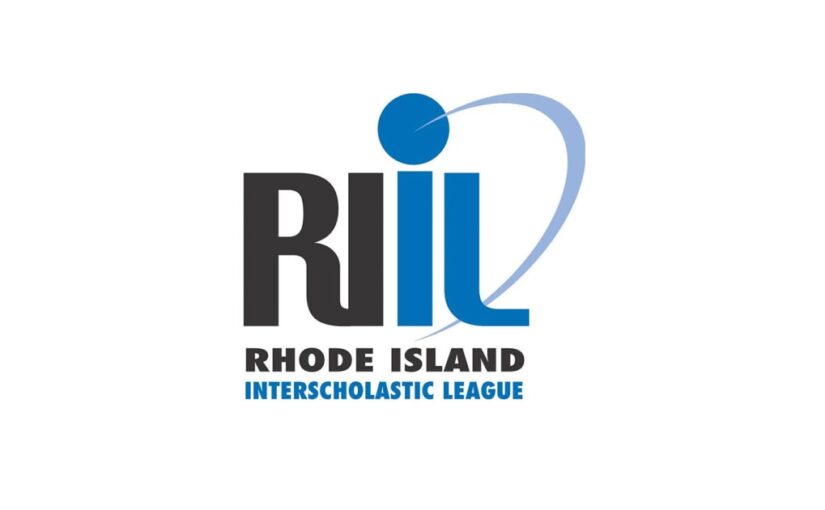10th Annual Athletic Directors Survey
Are high school athletic programs struggling financially? How have athletic departments responded to the COVID-19 pandemic? Which sports are being added to athletic departments in the not-so-distant future? These are a few of the questions we answer in our 2021 State of the Industry survey of high school athletic administrators — the 10th year in which we’ve conducted this nationwide survey.
This year’s report offers a unique glimpse into the challenges athletics directors face on a daily basis and offers a look at some of the new issues popping up in schools, including an increased importance placed upon proper facility sanitization. This survey provides some perspective on the challenges and opportunities that exist in high school athletics, and it provides direction for Coach & Athletic Director, as we base our content throughout the year on the report’s findings. 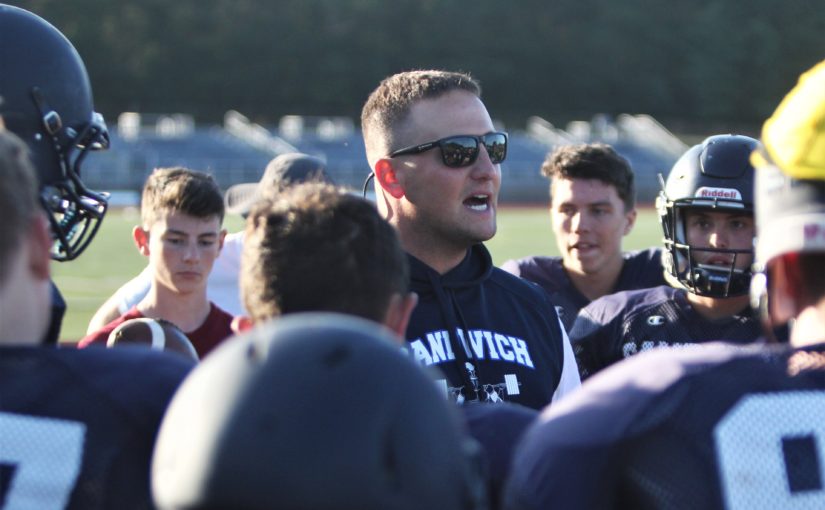
Top 5 Concerns Among Athletic Directors
- Health & Safety of Staff & Students — A new addition to the list of 23 options in the wake of the COVID-19 pandemic, the health and safety of staff and students far and away ranked as the most concerning issues facing athletic administrators in 2021 and beyond. While 92.3 percent of respondents were concerned about the well-being of their co-workers and student-athletes, 49 percent said they were most concerned.
“Protecting athletes and providing a safe environment is very important. Following safety protocols and stressing to everyone that minimizing outside contact is key to continuing the school’s and team’s health and future success for completing competition schedules,” one administrator stated.
Another noted, “COVID-19 bar none [is the most concerning issue]. This will evolve.”
- Reduced School Funding — It’s the one issue that had the greatest rise in concern from 2020 to this year, perhaps also from the coronavirus shadow that’s been cast over the country. Up three percent from a year ago, reduction in school funding rose from the third-biggest concern among administrators to the second biggest with 85.4 percent reporting at least some level of concern.
“Shutdowns from the COVID pandemic and financial hardship due to limited spectators at events. Solutions will come when we return to normal operations,” an administrator said.
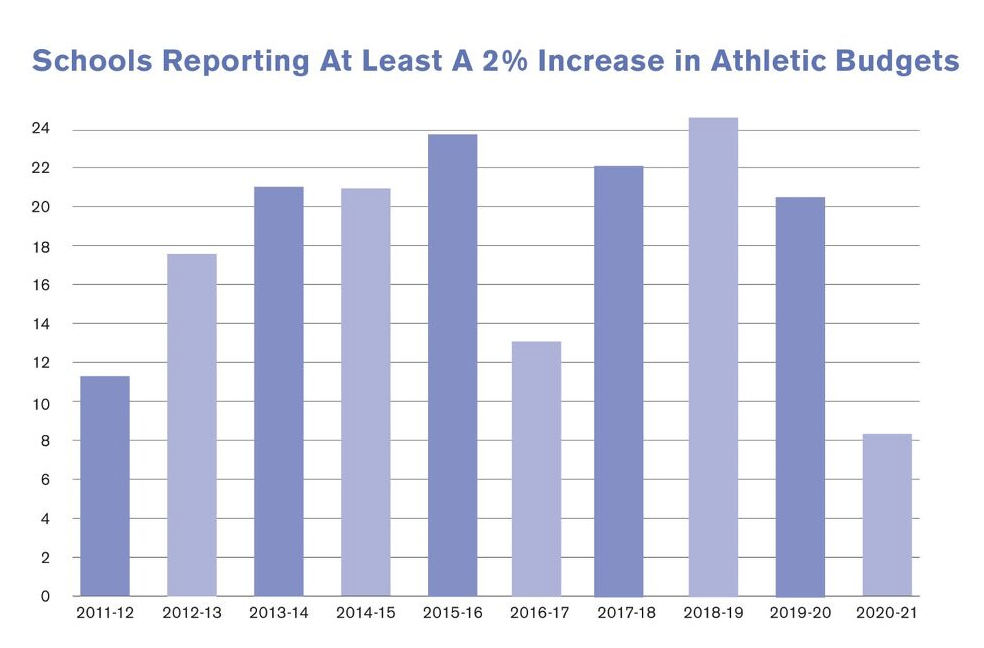 While the majority of respondents (59 percent) reported little or no change to their athletic department budgets from a year ago, 32.7 percent of respondents reported a two percent or more decrease in their budget. It is worth noting that 15 percent reported a budget of $500,000 or more, but 23.6 percent said their budgets were $50,000 or less.
While the majority of respondents (59 percent) reported little or no change to their athletic department budgets from a year ago, 32.7 percent of respondents reported a two percent or more decrease in their budget. It is worth noting that 15 percent reported a budget of $500,000 or more, but 23.6 percent said their budgets were $50,000 or less.
“It is going to make a huge financial impact,” another administrator opined.
- Finding Qualified Coaches — This has been the most concerning issue for athletic administrators over the last six years, taking the top spot once again in 2020 with 93.3 percent of responses. But in 2021, with coronavirus looming large, finding qualified coaches suddenly took a back seat to more pressing issues noted above. With 84.7 percent of respondents noting hiring good coaches, this issue saw a nine percent decrease from a year ago.
“Candidates really have to have a love of coaching and giving back to interscholastic athletics because of the increased time, decrease in pay that is required,” one administrator said.
Another said that it’s concerning that they have to “work with coaches and teams on behavior skill development.” - Facility Sanitization & Maintenance — Another newcomer to the list of selections in 2021, facility sanitation and maintenance quickly shot up the ranks of what’s concerning athletic administrators most, earning 83.6 percent of the response and the second-highest mostly concerned response of 40.4 percent. Along with the health and safety of staff and student-athletes, facility sanitization has been paramount in schools and athletics resuming safely across the country.
Many administrators noted the purchase of personal protective equipment (PPE), regularly cleaning equipment, and establishing new and improved protocols and plans of action. Additionally, nearly every respondent said they continuously work with state, local, and conference association officials on obtaining the most up-to-date information to stay ahead of the curve. - TIED
- Finding Staff for Events — The second-most concerning issue in 2020 also saw a decline back to its five-year average ranking. Garnering 79.6 percent of responses, finding staff for events saw a five percent dip from 2020 as events came to a complete standstill back in March and reduced capacity events were slowly rolled out across the country.
The spike up in 2020 was noted by some by “bulldozer parents.” As one respondent stated, “Bulldozer parents are always an issue. I’m not sure what the answer is to get more people wanting to be involved in helping with athletics. If parents help you, many times it seems like they expect their student-athlete to receive preferential treatment in their sport.”
But in 2021, the level of concern matched the rankings in previous surveys, with fourth in 2019, fifth in 2018, sixth in 2017, and seventh in 2016, respectively. - Athlete Participation Decline — Usually among the top 10 most-concerning issues among athletic administrators, declining participation saw a rise in 2021. With a five percent decrease to 79.6 percent, participation decline is back at the forefront of the collective mind of athletic administrators.
“[There has been] a continued decrease in participation. For example, in just five years our football program has dropped from 135 players at three levels to 85 players at two levels,” one administrator said.
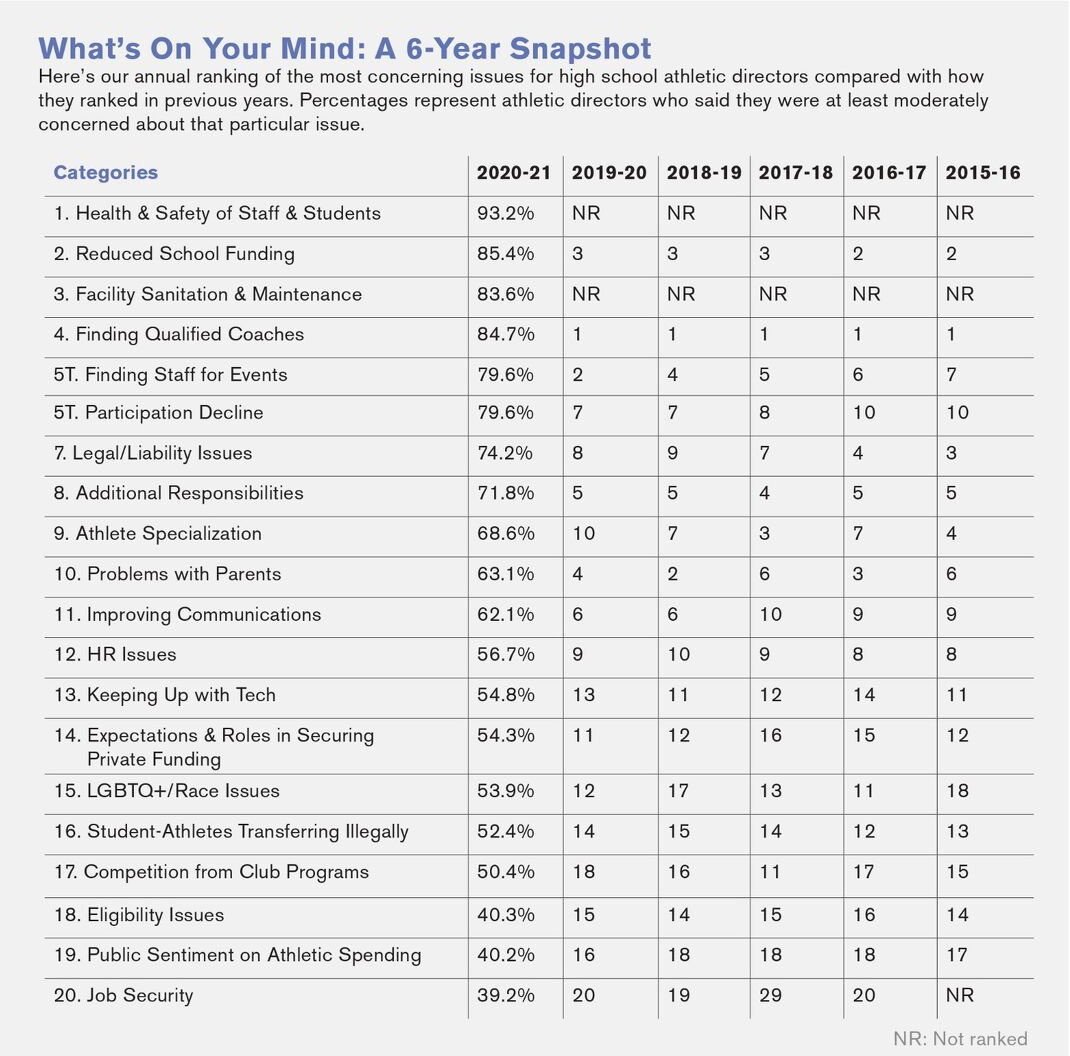 Some administrators attributed the participation decline in high school athletics to the rise of sports specialization and the importance placed on club sports. “It seems to me that Clubs need to work with state associations to develop a plan where everyone can share these students. With the change in scheduling this year with COVID, I already have coaches worried that their spring sports athletes will choose to play with their club teams over their high school teams. It would be nice if the clubs would encourage their players to play for their high school teams,” another administrator said.
Some administrators attributed the participation decline in high school athletics to the rise of sports specialization and the importance placed on club sports. “It seems to me that Clubs need to work with state associations to develop a plan where everyone can share these students. With the change in scheduling this year with COVID, I already have coaches worried that their spring sports athletes will choose to play with their club teams over their high school teams. It would be nice if the clubs would encourage their players to play for their high school teams,” another administrator said.
- Finding Staff for Events — The second-most concerning issue in 2020 also saw a decline back to its five-year average ranking. Garnering 79.6 percent of responses, finding staff for events saw a five percent dip from 2020 as events came to a complete standstill back in March and reduced capacity events were slowly rolled out across the country.
COVID-19 Effects
The ramifications of the coronavirus pandemic has no doubt impacted schools and, specifically, high school athletics. According to our survey results, 41 percent of respondents said they had to cancel at least one sports season this year in light of health and safety concerns. Additionally, nearly 91 percent of respondents reported altering their athletic schedule — playing conference-only slates, scheduling close-proximity schools, pushing a season to a different point in time, etc.
Some administrators noted the importance of communication over the last 10 months, both with the student-athletes and parents while going through lots of training on protocols with the rest of the coaching staff. Many others pointed to stockpiling PPE and sanitizer while limiting fan attendance in areas where games have been permitted. That’s evident by 83.6 percent of administrators polled pointed to facility sanitization as a concern this year. Additionally, 92 percent found the health and safety of student-athletes and staff the most concerning issue of the year.
“We try to follow the state guidelines and increase and enhance cleaning procedures,” one administrator noted.
What have you done to accommodate local, state, and federal regulations to safely return to athletics amid the COVID-19 pandemic?
“Followed all CDC, state department of health, conference, and national association guidelines.”
“We bought thermometers, conducted daily temperature checks, and had fewer athletes on buses.”
“For certain sports, we had to play at different times during the year. Seasons were shortened and we had no state tournament this year.”
“We moved all competitions to after 1/1/2021. We also have strict practice protocols with respect to distancing, masks, and limited contact.”
“We meet with our county health department every week to gauge the safety of return to play. We use those guidelines as well as those that we have developed in conjunction with the conference and local decision-makers to make sure that our players’ safety is the top priority.”
“All student-athletes wear a mask where mandated. The number of fans that can attend a game is limited. Masks must be worn by fans both inside and outside functions.”
What To Watch For: Athletic Directors Sound Off On Concerns for the Future
“The safety and well-being of our student-athletes and their families being negatively affected because of the ramifications that could come from our state reversing our decision in early September to ‘return to play’ on 9/28 instead of the planned December date. At the moment there are no potential solutions as we are entering the second week of competition with minimal schools that have had to shut down. Only one school in the state is totally shut down, with five other schools that have one to two teams quarantined for two weeks.”
“The continued pressure (perceived or real) on athletes and families to specialize in order to secure college athletic opportunities. The belief among athletes and families that club sports participation is more important and more valuable developmentally than school sports participation. Continue to emphasize the importance of multi-sport participation and the value of education and values-based athletic participation. Be more proactive in messaging to athletes and families that gaining college opportunities are much more about their daily effort and attitude than who they play with, for and against. For most athletes and sports the belief that club sports training and competition are better than school-based is a myth. Club sports typically help the top 5-10% of players while everyone else is subsidizing those players’ opportunities through expensive participation and travel fees. Most athletes would be better served by playing bigger roles on their school teams and investing the time they spend traveling in skill development and strength training.”
“Lack of hiring of good qualified coaches… Kids that spend all their time in the video game chair and cell phone…Technology, as good as it is, is ruining our participation numbers… Kids are lazy and many do not like to work hard…”
“I am greatly concerned about the behavior of spectators. It is not a problem that involves a great many people, but it only takes a few each season to tarnish a school.”
“Loss of participation. Mental health of student-athletes and coaches alike. The cost to maintain competitive teams. Whether COVID-19 will allow spring sports and sport schedules and participation in 2021-22.”
“Being able to fund the programs and meet the high standards set by parents. I fear the athletes will stop playing school sports and focus on clubs only.”
Girls Sports on the Rise
Adding more options for students to get involved in athletics continues to be a strong focal point of administrators across the country. Likewise, having more options available for girls’ sports has risen in recent years. Nearly 19 percent of respondents said they are going to add girls golf, girls bowling, and girls wrestling in the next three years. An additional 14 percent said they plan to add girls soccer and lacrosse in the coming years.
Other non-traditional sports administrators mentioned were pickleball, girls flag football, eSports, triathlons, archery, beach volleyball, and bass fishing among others. Shockingly the most-selected answer was boys soccer with 22.7 percent of the response, followed by girls golf and bowling.
Fundraising Efforts on the Rise
According to our results, fundraising efforts have been raised from a year ago. The nine-year average of schools where fundraising made up more than half of the athletic budget was 15.9 percent, but in 2021 17.3 percent reported that number — the highest number since our 2016-17 survey.
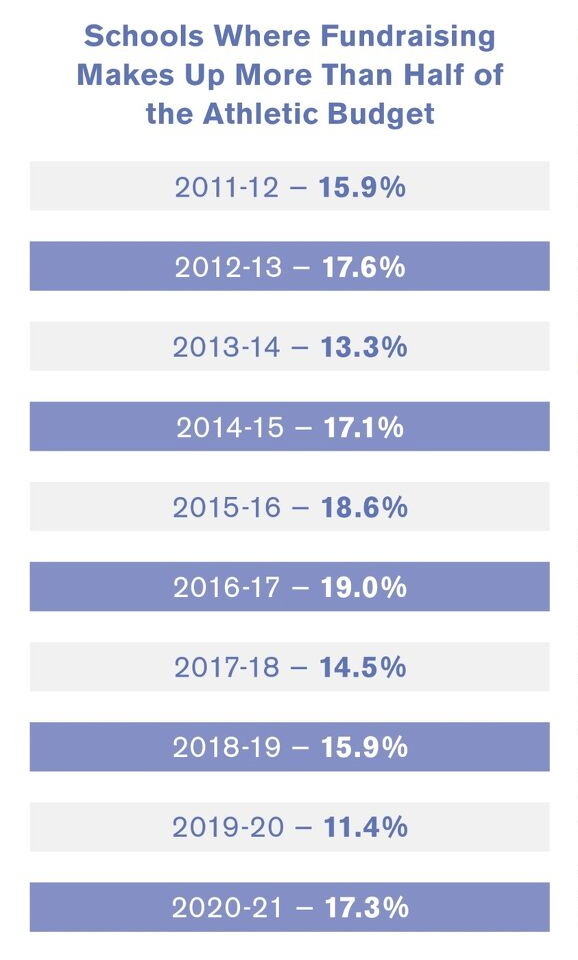 Also noteworthy was that 22.7 percent of respondents reported fundraising accounted for zero percent of their athletic budget. An additional 41.8 percent reported that fundraising accounted for 20 percent or less of their athletic budget.
Also noteworthy was that 22.7 percent of respondents reported fundraising accounted for zero percent of their athletic budget. An additional 41.8 percent reported that fundraising accounted for 20 percent or less of their athletic budget.
As was the case in 2020, the brunt of fundraising efforts fell on coaches with 71 percent of the response with booster clubs and the athletic director closely behind. With 32.7 percent of respondents reporting at least a two percent decrease in their athletic budgets, administrators know they need to make the most of every available dollar.
“We tried to minimize our reliance on outside coaches and maximize teacher/coaches, have better cost controls on uniforms and team apparel, and better cost controls on equipment,” one administrator said.
Another administrator noted they “order only what is necessary for the operation of the particular program. Athletic boosters help with extras. We have also cut our paid coaching staff.”

